The Progressive Damage Modeling of Composite–Steel Lapped Joints
Abstract
1. Introduction
2. Numerical Modeling
2.1. Progressive Damage Model
2.2. Bolted Joint Model Description and Boundary Conditions
2.3. Contact Properties
2.4. Clamping Force
2.5. Effect of Clamping Force and Friction Coefficient
3. Results and Discussion
3.1. Validation of Finite Element Model
3.2. Strength of Single and Double-Lapped Joint
3.3. Stiffness of Single and Double-Lapped Joint
3.4. Load Transferee Analysis
4. Conclusions and Recommendations
- The material model was developed and used to build an FE model that was able to predict the experiment with a difference of 3%.
- Using a double-lap joint configuration, where the composite plate is positioned between two steel plates, increased the joint capacity by more than 200%.
- Increasing the clamping force led to a significant improvement in the strength of both 3DS and 3DD joints, up to a certain limit.
- Increasing the clamping force from 0 to 1600 N increased the capacity of the double-lapped joint by 96% while increasing that clamping force to 3200 N led only to the capacity increase of less than 1%. However, increasing the clamping force did not significantly affect the single-lapped joint.
- The stiffness of the 3DD joint was found to be nearly three times greater than that of the 3DS joint, primarily due to the rotational flexibility of the single-lap configuration, due to the asymmetry of the joint.
- Increasing the clamping force from 0 to 3200 N resulted in a stiffness increase of 16% for the 3DD configuration and 11% for the 3DS configuration. This improvement is attributed to the additional frictional resistance generated by the bolt pre-tension.
- Future research should focus on developing an advanced 3D coupled plasticity-damage model to more accurately simulate the nonlinear behavior of bolted joints. Additionally, incorporating viscoelastic-damage coupling will enable realistic modeling of polymer matrix behavior under cyclic and long-term loading conditions. Enhancing the framework to account for fatigue degradation mechanisms is also essential for predicting the durability and service life of composite bolted joints.
Author Contributions
Funding
Data Availability Statement
Conflicts of Interest
References
- Kradinov, V.; Madenci, E.; Ambur, D.R. Combined In-Plane and through-the-Thickness Analysis for Failure Prediction of Bolted Composite Joints. Compos. Struct. 2007, 77, 127–147. [Google Scholar] [CrossRef]
- Camanho, P.P.; Matthews, F.L.; Running, D.M.; Ligon, J.B.; Miskioglu, I.; Camanho, P.P.; Matthews, F.L. A Progressive Damage Model for Mechanically Fastened Joints in Composite Laminates. J. Compos. Mater. 1999, 33, 2248–2280. [Google Scholar] [CrossRef]
- Camanho, P.P.; Bowron, S.; Matthews, F.L. Failure Mechanisms in Bolted CFRP. J. Reinf. Plast. Compos. 1998, 17, 205–233. [Google Scholar] [CrossRef]
- El-Sisi, A.E.-D.; Sallam, H.E.-D.; Salim, H.; El-Husseiny, O. Structural Behavior of Hybrid CFRP/Steel Bolted Staggered Joints. Constr. Build. Mater. 2018, 190, 1192–1207. [Google Scholar] [CrossRef]
- Sun, H.-T.; Chang, F.-K.; Qing, X. The Response of Composite Joints with Bolt-Clamping Loads, Part I: Model Development. J. Compos. Mater. 2002, 36, 47–67. [Google Scholar] [CrossRef]
- Vangrimde, B.; Boukhili, R. Bearing Stiffness of Glass Fibre-Reinforced Polyester: Influence of Coupon Geometry and Laminate Properties. Compos. Struct. 2002, 58, 57–73. [Google Scholar] [CrossRef]
- Hou, L.; Liu, D. Size Effects and Thickness Constraints in Composite Joints. J. Compos. Mater. 2003, 37, 1921–1938. [Google Scholar] [CrossRef]
- Cooper, C.; Turvey, G.J. Effects of Joint Geometry and Bolt Torque on the Structural Performance of Single Bolt Tension Joints in Pultruded GRP Sheet Material. Compos. Struct. 1995, 32, 217–226. [Google Scholar] [CrossRef]
- Oh, J.H.; Kim, Y.G.; Lee, D.G. Optimum Bolted Joints for Hybrid Composite Materials. Compos. Struct. 1997, 38, 329–341. [Google Scholar] [CrossRef]
- Aktas, A.; Husnu Dirikolu, M. An Experimental and Numerical Investigation of Strength Characteristics of Carbon-Epoxy Pinned-Joint Plates. Compos. Sci. Technol. 2004, 64, 1605–1611. [Google Scholar] [CrossRef]
- Aktaş, A. Bearing Strength of Carbon Epoxy Laminates under Static and Dynamic Loading. Compos. Struct. 2005, 67, 485–489. [Google Scholar] [CrossRef]
- McCarthy, M.A.; Lawlor, V.P.; Stanley, W.F.; McCarthy, C.T. Bolt-Hole Clearance Effects and Strength Criteria in Single-Bolt, Single-Lap, Composite Bolted Joints. Compos. Sci. Technol. 2002, 62, 1415–1431. [Google Scholar] [CrossRef]
- Lawlor, V.P.; McCarthy, M.A.; Stanley, W.F. Experimental Study on Effects of Clearance on Single Bolt, Single Shear, Composite Bolted Joints. Plast. Rubber Compos. 2002, 31, 405–411. [Google Scholar] [CrossRef]
- Girard, C.; Dano, M.-L.; Picard, A.; Gendron, G. Bearing Behavior of Mechanically Fastened Joints in Composite Laminates--Part II: Failure Mechanisms. Mech. Adv. Mater. Struct. 2003, 10, 23–42. [Google Scholar] [CrossRef]
- Park, H.-J.J. Effects of Stacking Sequence and Clamping Force on the Bearing Strengths of Mechanically Fastened Joints in Composite Laminates. Compos. Struct. 2001, 53, 213–221. [Google Scholar] [CrossRef]
- Sadowski, T.; Golewski, P. Effect of Tolerance in the Fitting of Rivets in the Holes of Double Lap Joints Subjected to Uniaxial Tension. Key Eng. Mater. 2014, 607, 49–54. [Google Scholar] [CrossRef]
- Sun, H.-T.; Chang, F.-K.; Qing, X.; Mc, A.; Sun, H.-T.; Chang, F.-K.; Qing, X. The Response of Composite Joints with Bolt-Clamping Loads, Part II: Model Verification. J. Compos. Mater. 2002, 36, 69–92. [Google Scholar] [CrossRef]
- Yan, Y.; Wen, W.-D.; Chang, F.-K.; Shyprykevich, P. Experimental Study on Clamping Effects on the Tensile Strength of Composite Plates with a Bolt-Filled Hole. Compos. Part A Appl. Sci. Manuf. 1999, 30, 1215–1229. [Google Scholar] [CrossRef]
- Khashaba, U.A.; Sallam, H.E.M.; Al-Shorbagy, A.E.; Seif, M.A. Effect of Washer Size and Tightening Torque on the Performance of Bolted Joints in Composite Structures. Compos. Struct. 2006, 73, 310–317. [Google Scholar] [CrossRef]
- Pietropaoli, E. Progressive Failure Analysis of Composite Structures Using a Constitutive Material Model (USERMAT) Developed and Implemented in ANSYS. Appl. Compos. Mater. 2012, 19, 657–668. [Google Scholar] [CrossRef]
- Tan, S.C. A Progressive Failure Model for Composite Laminates Containing Openings. J. Compos. Mater. 1991, 25, 556–577. [Google Scholar] [CrossRef]
- Nuismer, R.J.; Tan, S.C. Constitutive Relations of a Cracked Composite Lamina. J. Compos. Mater. 1988, 22, 306–321. [Google Scholar] [CrossRef]
- Matzenmiller, A.; Lubliner, J.; Taylor, R.L. A Constitutive Model for Anisotropic Damage in Fiber-Composites. Mech. Mater. 1995, 20, 125–152. [Google Scholar] [CrossRef]
- Lonetti, P.; Zinno, R.; Greco, F.; Barbero, E.J.E.; Zinno, R.; Greco, F. Interlaminar Damage Model for Polymer Matrix. J. Compos. Mater. 2003, 37, 1485–1504. [Google Scholar] [CrossRef]
- Maimí, P.; Camanho, P.P.; Mayugo, J.A.; Dávila, C.G. A Continuum Damage Model for Composite Laminates: Part I—Constitutive Model. Mech. Mater. 2007, 39, 897–908. [Google Scholar] [CrossRef]
- Maimí, P.; Camanho, P.P.; Mayugo, J.A.; Dávila, C.G. A Continuum Damage Model for Composite Laminates: Part II—Computational Implementation and Validation. Mech. Mater. 2007, 39, 909–919. [Google Scholar] [CrossRef]
- Chen, J.F.; Morozov, E.V.; Shankar, K.; Technology, I. Plastic Damage Model for Progressive Failure Analysis of Composite Structures. In Proceedings of the 18th International Conference on Composite Materials, Jeju Island, Republic of Korea, 21–26 August 2009. [Google Scholar]
- Chen, J.F.; Morozov, E.V.; Shankar, K. A Combined Elastoplastic Damage Model for Progressive Failure Analysis of Composite Materials and Structures. Compos. Struct. 2012, 94, 3478–3489. [Google Scholar] [CrossRef]
- Kim, E.-H.; Rim, M.-S.; Lee, I.; Hwang, T.-K. Composite Damage Model Based on Continuum Damage Mechanics and Low Velocity Impact Analysis of Composite Plates. Compos. Struct. 2013, 95, 123–134. [Google Scholar] [CrossRef]
- Bažant, Z.P.; Oh, B.H. Crack Band Theory for Fracture of Concrete. Matériaux Constr. 1983, 16, 155–177. [Google Scholar] [CrossRef]
- Turon, A.; Da’vila, C.G.; Camanho, P.P.; Costa, J. An Engineering Solution for Mesh Size Effects in the Simulation of Delamination Using Cohesive Zone Models. Eng. Fract. Mech. 2007, 74, 1665–1682. [Google Scholar] [CrossRef]
- Frank, A. Leone Full-Scale Testing and Progressive Damage Modeling of Sandwich Composite Aircraft Fuselage Structure. Ph.D. Thesis, Drexel University, Philadelphia, PA, USA, 2010. [Google Scholar]
- ANSYS, Inc. ANSYS Release 2025 Documentation; ANSYS, Inc.: Canonsburg, PA, USA, 2025. [Google Scholar]
- Suemasu, H.; Takahashi, H.; Ishikawa, T. On Failure Mechanisms of Composite Laminates with an Open Hole Subjected to Compressive Load. Compos. Sci. Technol. 2006, 66, 634–641. [Google Scholar] [CrossRef]
- Shan, M.; Liu, F.; Fang, Z.; Zhao, L.; Zhang, J. A Bi-Material Property Based FE Modelling Method for Progressive Damage Analyses of Composite Double-Lap Bolted Joints. Results Phys. 2018, 11, 674–683. [Google Scholar] [CrossRef]
- Barbero, E.J. Finite Element Analysis of Composite Material by Using ABAQUS; CRC Press: Boca Raton, FL, USA, 2013. [Google Scholar]
- El-Sisi, A.E.-D.A.; El-Emam, H.M.; Salim, H.A.; Sallam, H.M. Efficient 3D Modeling of Damage in Composite Materials. J. Compos. Mater. 2014, 49, 817–828. [Google Scholar] [CrossRef]
- Riccio, A.; Marciano, L. Effects of Geometrical and Material Features on Damage Onset and Propagation in Single-Lap Bolted Composite Joints under Tensile Load: Part I—Experimental Studies. J. Compos. Mater. 2005, 39, 2071–2090. [Google Scholar] [CrossRef]
- Riccio, A. Effects of Geometrical and Material Features on Damage Onset and Propagation in Single-Lap Bolted Composite Joints under Tensile Load: Part II—Numerical Studies. J. Compos. Mater. 2005, 39, 2091–2112. [Google Scholar] [CrossRef]
- El-Sisi, A.E.-D.A.; Salim, H.A.; El-Hussieny, O.M.; Sallam, H.E.-D.M. Behaviors of a Cracked Lapped Joint under Mixed Mode Loading. Eng. Fail. Anal. 2014, 36, 134–146. [Google Scholar] [CrossRef]

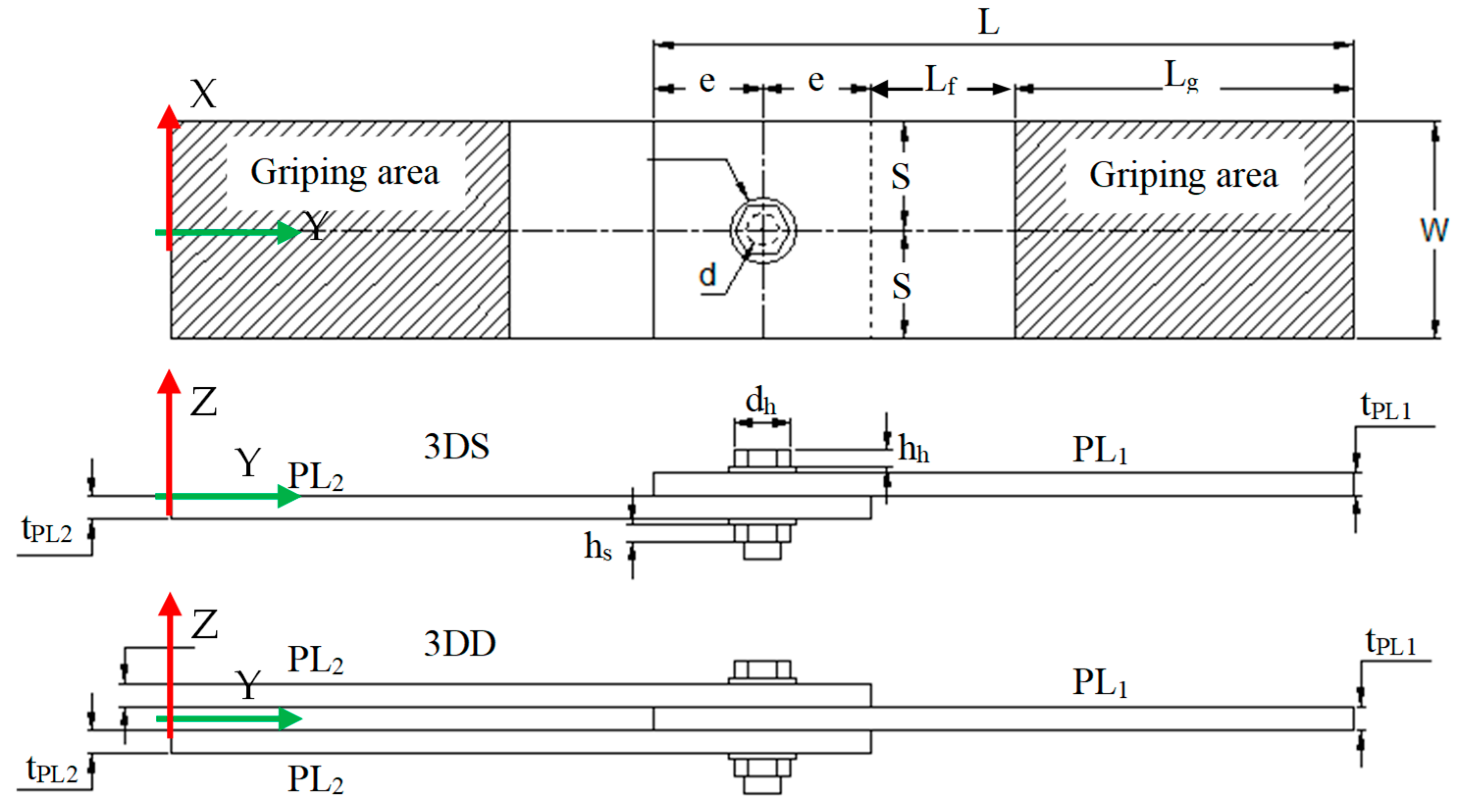


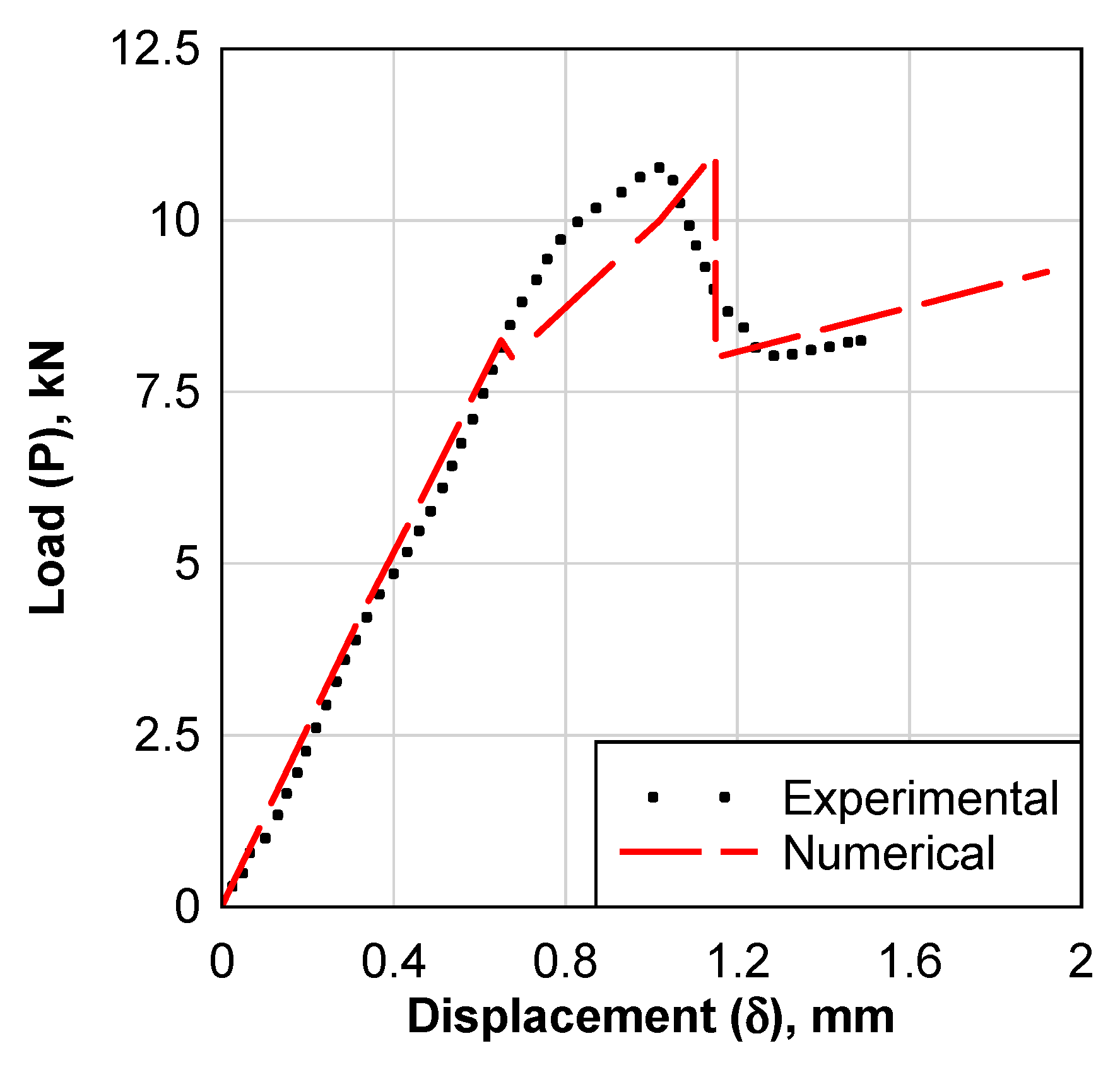




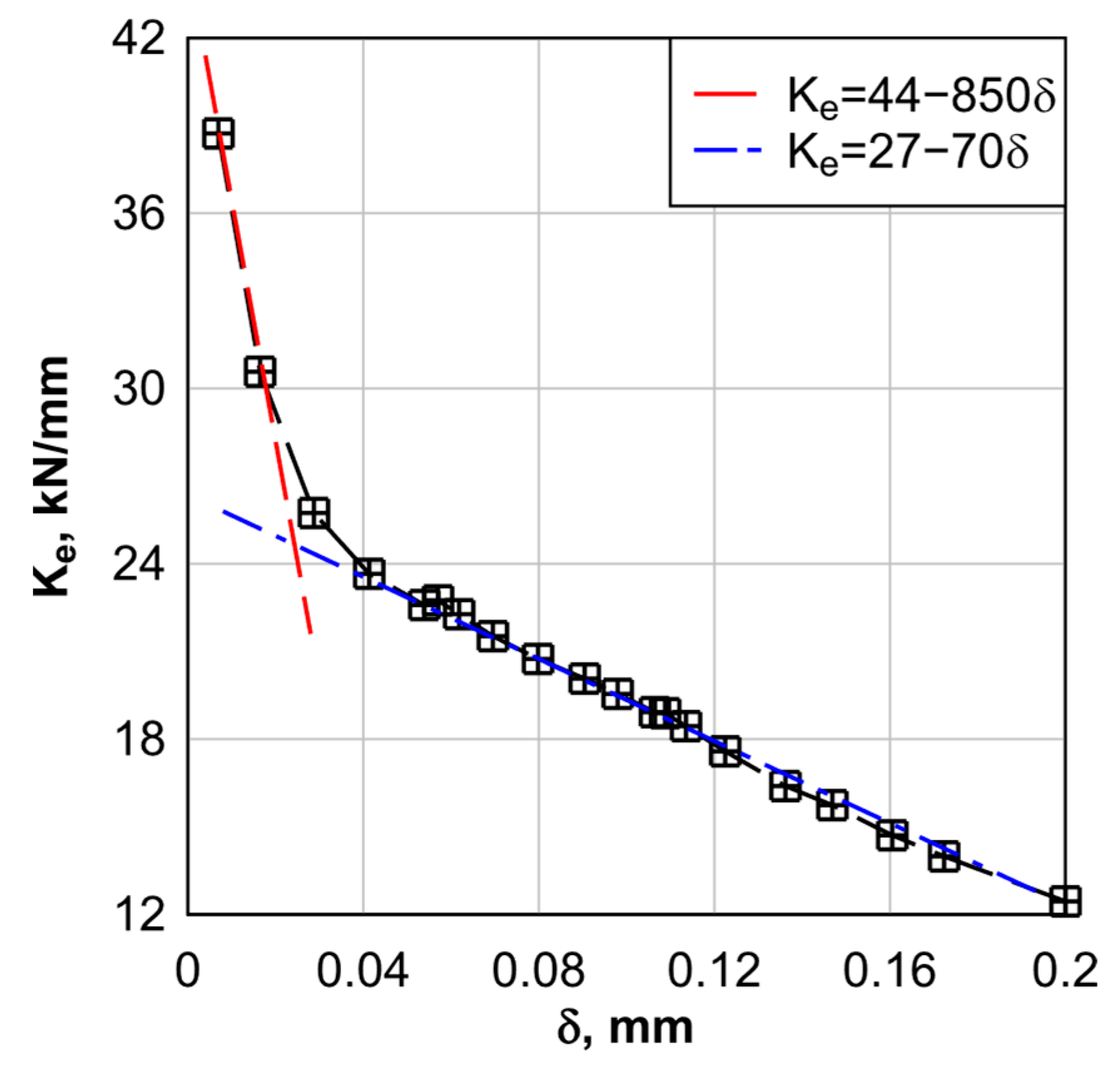
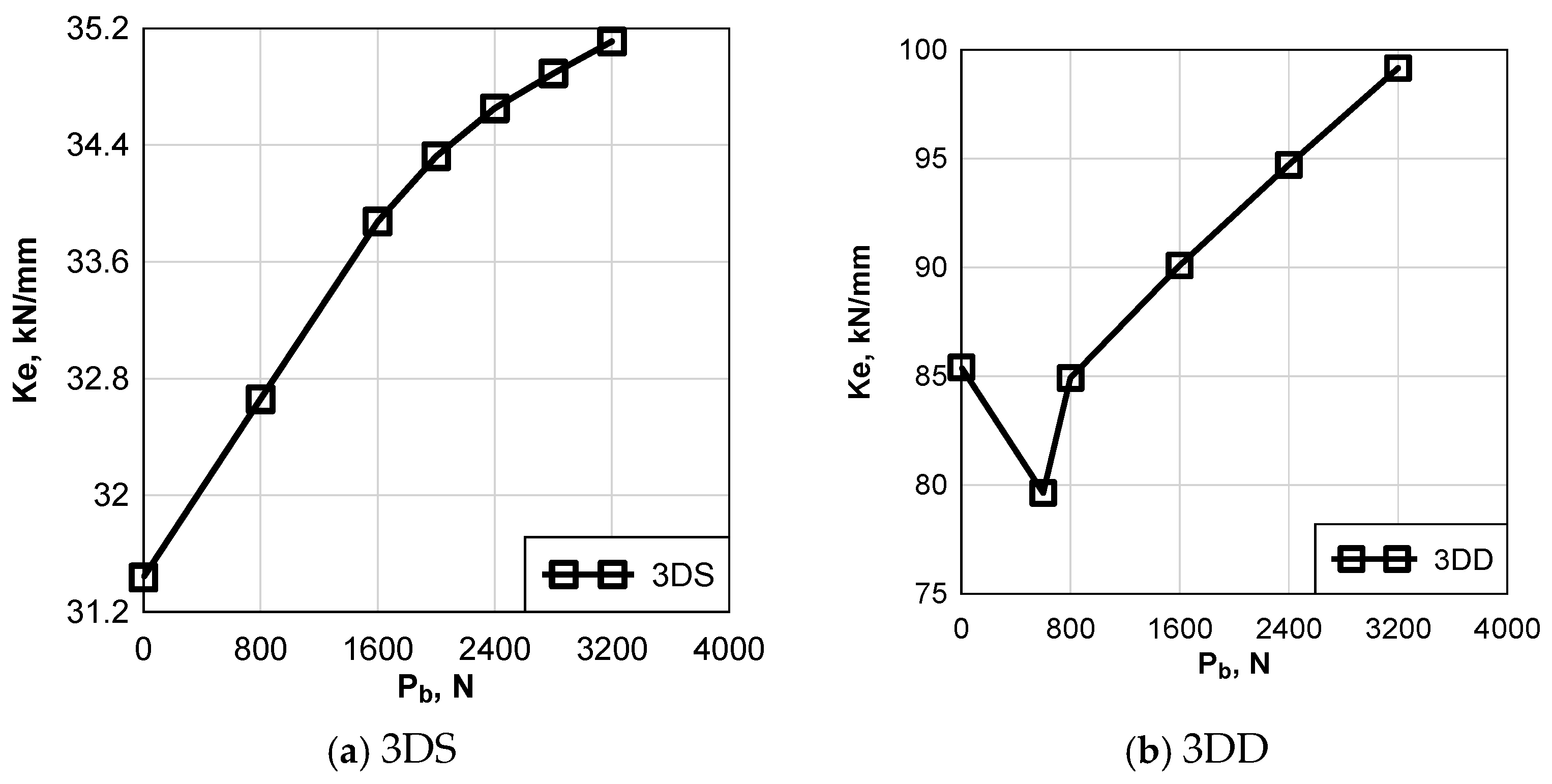
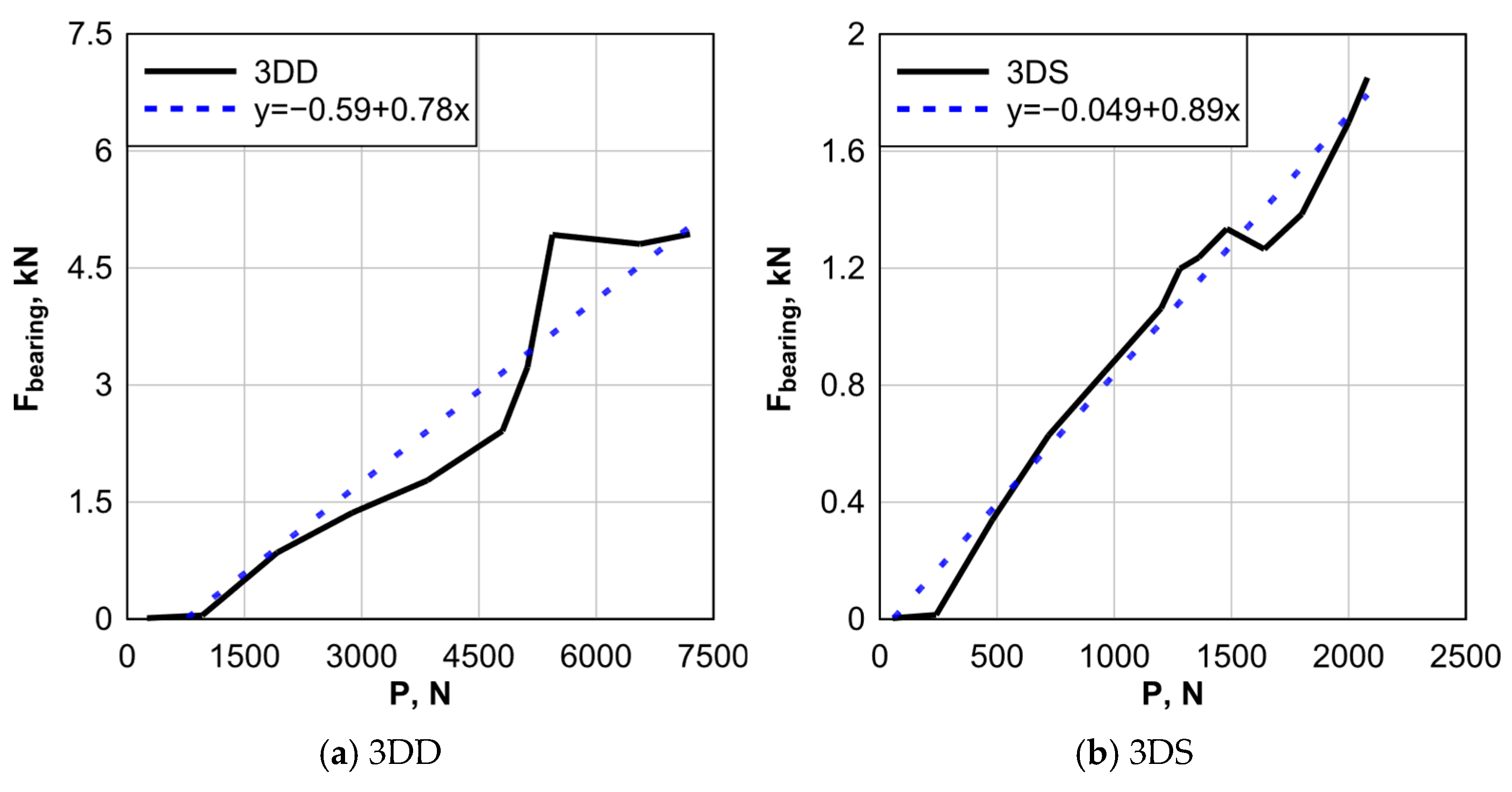
| Damage Direction | Tension | Compression |
|---|---|---|
| Fiber Direction 1 | ||
| Matrix Direction 2 | ||
| Matrix Direction 3 |
| Item | E (GPa) | ν |
|---|---|---|
| Steel Plates, Nuts, and Washers | 200 | 0.3 |
| Aluminum Alloy Plates | 70 | 0.29 |
| Titanium Bolts | 110 | 0.29 |
| Stiffness Parameters | Strength Parameters | Fracture Toughness | |||
|---|---|---|---|---|---|
| E1 | 146.8 GPa | St1 | 1730 MPa | Gt1 | 89.83 N/mm |
| E2 | 11.4 GPa | Sc1 | 1370 MPa | Gc1 | 78.27 N/mm |
| G12 | 6.1 GPa | St2 | 66.5 MPa | Gt2 | 0.43 N/mm |
| ν12 | 0.3 | Sc2 | 268.2 MPa | Gc2 | 0.76 N/mm |
| Ss12 | 58.2 MPa | Gs12 | 0.46 N/mm | ||
| Stiffness Parameters | Strength Parameters, MPa | ||
|---|---|---|---|
| E1 | 145 GPa | St1 | 2250 |
| E2 | 10.30 GPa | Sc1 | 1600 |
| G12 | 5.30 GPa | St1 | 64 |
| ν12 | 0.3 | Sc2 | 290 |
| Ss12 | 120 | ||
| Clamping Force (N) | Failure Load (kN) | |
|---|---|---|
| 3DD | 3DS | |
| 1 | 7.26 | 1.90 |
| 600 | 10.48 | 2.05 |
| 800 | 11.58 | 2.09 |
| 1600 | 14.24 | 2.23 |
| 2400 | 14.4 | 2.41 |
| 3200 | 14.4 | 2.45 |
Disclaimer/Publisher’s Note: The statements, opinions and data contained in all publications are solely those of the individual author(s) and contributor(s) and not of MDPI and/or the editor(s). MDPI and/or the editor(s) disclaim responsibility for any injury to people or property resulting from any ideas, methods, instructions or products referred to in the content. |
© 2025 by the authors. Licensee MDPI, Basel, Switzerland. This article is an open access article distributed under the terms and conditions of the Creative Commons Attribution (CC BY) license (https://creativecommons.org/licenses/by/4.0/).
Share and Cite
El-Sisi, A.; Elbelbisi, A.; Elkilani, A.; Salim, H. The Progressive Damage Modeling of Composite–Steel Lapped Joints. J. Compos. Sci. 2025, 9, 350. https://doi.org/10.3390/jcs9070350
El-Sisi A, Elbelbisi A, Elkilani A, Salim H. The Progressive Damage Modeling of Composite–Steel Lapped Joints. Journal of Composites Science. 2025; 9(7):350. https://doi.org/10.3390/jcs9070350
Chicago/Turabian StyleEl-Sisi, Alaa, Ahmed Elbelbisi, Ahmed Elkilani, and Hani Salim. 2025. "The Progressive Damage Modeling of Composite–Steel Lapped Joints" Journal of Composites Science 9, no. 7: 350. https://doi.org/10.3390/jcs9070350
APA StyleEl-Sisi, A., Elbelbisi, A., Elkilani, A., & Salim, H. (2025). The Progressive Damage Modeling of Composite–Steel Lapped Joints. Journal of Composites Science, 9(7), 350. https://doi.org/10.3390/jcs9070350









